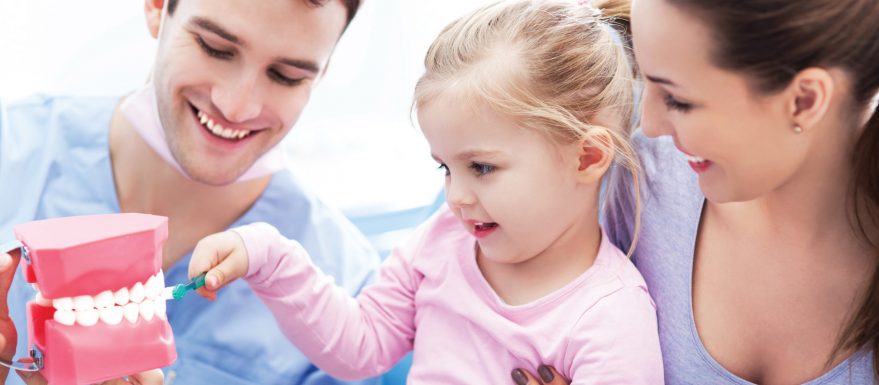Starting small: How to care for kids’ teeth

Queensland Health estimates around 55% of children aged five to 14 have a history of tooth decay, suggesting many children do not have healthy habits when it comes to their teeth. Oral Health Therapist, Rachel Botros, is skilled in working with babies and children to support dental hygiene. Here, Rachel answers some common questions around dental care for kids.
Why is it important to check my child’s teeth?
Baby teeth serve several important functions for both dental and overall health.
1) Your child requires teeth for eating, with the front teeth designed for biting and the back teeth for chewing. 2) Our teeth are important for speech and communicating clearly. 3) The teeth and smile are important for self-esteem. 4) The baby teeth also give a healthy start for the permanent teeth, as they save space for the adult teeth and eventually guide them into place.
When should I take my child for his/her first check up?
For most babies, the lower front two teeth will break through between four and six months. For others, it might be upwards of 12 months. The best age for your baby’s first visit to the dentist or oral health therapist is when your baby gets his or her first tooth. This first appointment is an opportunity for your dental professional to make sure your baby’s mouth is forming correctly, there are no issues with feeding or teething, early tongue ties or lip ties, and for you to get some good tips on dental care for your baby as he or she grows. It also begins the important habit of regular
check-ups.
“It’s quite a simple formula: Plaque + sugar = decay. You get plaque from not brushing your teeth and sugar from food and drink, then one plus the other equals decay.”
How do I clean my baby’s teeth?
To brush a baby’s teeth, run a baby toothbrush under warm tap water (not hot), to soften the bristles. Toothpaste isn’t necessary, but if you prefer to use it, use a teensy smear and make sure it’s age appropriate. Brush in soft, gentle circles on baby’s tooth/teeth. Alternatively, take a soft face cloth, dip it in warm water, wrap it around your finger and rub baby’s teeth gently in soft circles. A warning though, teething babies tend to bite!
What age should children start flossing?
Around the age of five to six, your child’s big molars at the very back of their mouth will begin pushing through, hence the term “six-year-old molars”. This pushes the baby molars closer together, and makes it harder to clean between the teeth. The most common area children get decay is between the teeth. It can be difficult to floss small mouths using adult hands, but there are some terrific products on the market, like Little Flossers, which have a handle and a piece of floss across the top. These make it easy for mum or dad to floss tiny teeth, and show young ones how to floss on their own as they grow from toddler to child.
Is decay normal?
Many people believe decay is normal, but it’s completely preventable. It’s quite a simple formula: Plaque + sugar = decay. You get plaque from not brushing your teeth and sugar from food and drink, then one plus the other equals decay. Unfortunately, decay is not one of those things that is painful until it’s in its very end stages. It is quite common for pre-school and school-aged children to come in for a standard check-up and clean where we discover decay that neither the child or parents were aware of. By removing plaque (with regular brushing and flossing) and reducing sugar intake (with good nutrition choices) you will lessen the likelihood of decay.
What kind of healthy habits can I start with my child to help reduce the risk of decay?
- Good brushing habits, early on – Introduce brushing from an early age. Increase the length of time they brush as they get older; the end goal is to set the habit of brushing teeth for 2-3 minutes, or, if it helps, count to three for each tooth so they mindfully brush each tooth and know when to stop. Have them angle the toothbrush towards the gums so the brush covers half tooth and half gum, and brush in gentle, baby circles.
- Good nutrition, early on – Poor nutrition is a major cause of dental decay in children aged 5-14. Avoid sugary drinks like juice, soft drink and flavoured milk, and opt for plain milk or tap water. Check your food labels too. Every full gram of sugar equals one teaspoon of sugar. Nutrigrain, as an example, is marketed as muscle-man food but has only one or two teaspoons less sugar than Froot Loops. So, make Nutrigrain Saturday morning treat instead of an everyday breakfast food. Choose fresh fruit over dried fruit, which is sticky, is concentrated in sugar and has no water content, all of which cause damage to teeth.
Which treats are better for my child’s teeth?
Avoid anything sticky such as toffees, caramels and Minties, as they stick to the teeth and are hard to wash or brush away. Instead, choose something that melts, like chocolate or ice cream. The best time to give them a treat is after dinner, as they will brush their teeth before bed.






